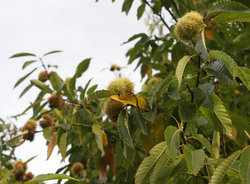» View the recipes involving chestnut
 Chestnuts (Castanea), including the chinkapins, are a genus of eight or nine species of trees and shrubs in the beech family Fagaceae, native to warm temperate regions of the Northern Hemisphere. The name also refers to the nuts produced by these trees. Most are large trees to 20-40 m tall, but some species (the chinkapins) are smaller, often shrubby. All are deciduous. Chestnuts (Castanea), including the chinkapins, are a genus of eight or nine species of trees and shrubs in the beech family Fagaceae, native to warm temperate regions of the Northern Hemisphere. The name also refers to the nuts produced by these trees. Most are large trees to 20-40 m tall, but some species (the chinkapins) are smaller, often shrubby. All are deciduous.
The leaves are simple, ovate or lanceolate, 10-30 cm long and 4-10 cm broad, with sharply pointed, widely-spaced teeth, with shallow rounded sinuses between. The flowers are catkins, produced in mid summer. The fruit is a spiny cupule 5-11 cm diameter, containing 2-7 nuts. The American Chestnut, formerly one of the dominant trees of the eastern United States, has been almost wiped out by a fungal disease, chestnut blight Cryphonectria parasitica. The American chinkapins are also very susceptible to chestnut blight. The European and west Asian Sweet Chestnut is susceptible, but less so than the American, and the east Asian species are resistant. These resistant species, particularly Japanese Chestnut and Chinese Chestnut but also Seguin's Chestnut and Henry's Chestnut, have been used in breeding programs in the US to create hybrids with the American chestnut that are also disease resistant. The nuts are most commonly eaten roasted or candied; the latter are often sold under the French name marrons glacs. The wood is moderately useful, similar to oak wood in being decorative and very durable, but of low value due to the high degree of splitting and warping when it dries. This makes large pieces of wood difficult to obtain; most chestnut wood is used in small items where the durability is important, such as fencing and wooden outdoor cladding ('shingles') for buildings. The bark was also a useful source of natural tannins, used for tanning leather before the introduction of synthetic tannins. To preserve chestnuts to eat through the winter, they must be made perfectly dry after they come out of their green husk; then put into a box or a barrel mixed with, and covered over by, fine and dry sand, three parts of sand to one part of chestnuts. Any maggots in any of the chestnuts will emerge and work up through the sand to get to the air without damaging other chestnuts. Chestnuts to be grown in the spring need to be kept in moist sand and chilled over the winter.
Season specials: Easter Recipes, Passover Recipes, Christmas Recipes, Season Recipes, Xmas Recipes
|